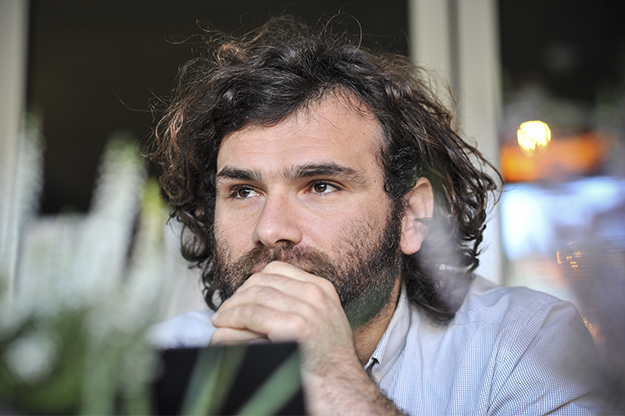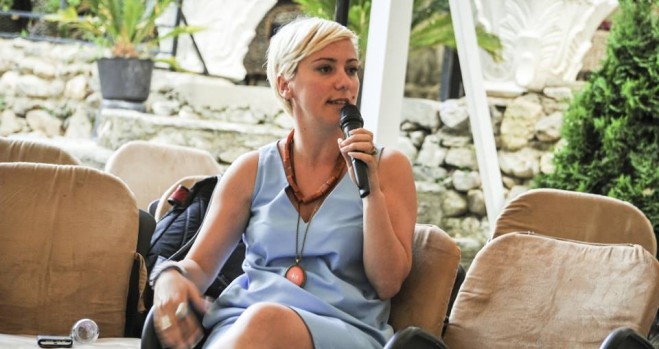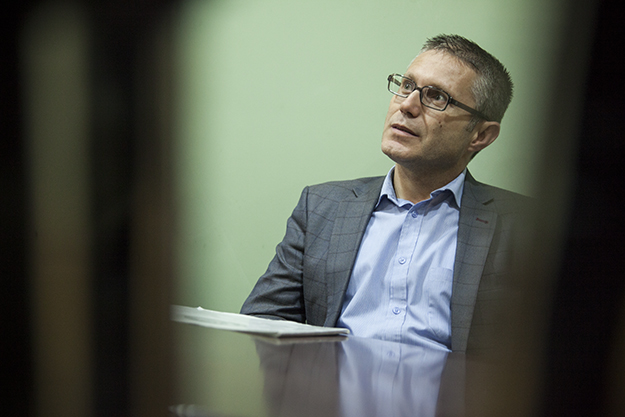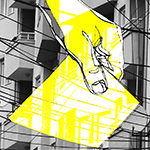“Whoever thinks the war in Kosovo was a war of nations is in over their head. They came to fight Islam.”
These words were uttered by Naman Demolli in 2011 in a speech given opposite the planned location of the Mother Teresa Cathedral in Prishtina. Around this time Demolli and a group of youngsters, among them Lavdrim Muhaxheri, also appeared in two separate recordings published on YouTube, protesting against the decision to build the cathedral in the Kosovar capital. They wanted a mosque instead.
A year later, Naman Demolli from Prishtina, would become the first fighter from Kosovo to be killed as a jihadist in Syria within the ranks of what would become known as the Islamic State of Iraq and Syria (today known as Islamic State, IS) in the war against Bashar al-Assad. News of his death came from his relatives in November 2012, at a time when the whole world had begun to take sides in the complex and drawn out war.
During a speech at the international conference titled “Friends of the Syrian People” two years earlier on July 6, 2010, Kosovo’s then minister of internal affairs, Enver Hoxhaj, had clearly set out Kosovo’s alignment with countries such as the U.S., Great Britain, Germany, France and Belgium, who had publicly denounced Assad and supported the opposition. “Assad is Milosevic, and we are the opposition,” Hoxhaj told the 100 world leaders who had gathered in Paris.
This narrative of comparing Assad to Milosevic would become the same one used by IS recruits, including Demolli, who aimed to convince as many young supporters from Kosovo and other states to fight alongside them as jihadis in the war “for the protection of Islam.” A study titled “The Islamic State narrative in Kosovo, deconstructed one story at a time” that was published by the Kosovar Center for Security Studies (KCSS) in September, offered the following assessment of Demolli’s early public presentations:
“When Naman Demolli spoke with contempt about the newly constructed Roman Catholic Cathedral in the center of Kosovo’s capital Prishtina, few paid attention to his strenuous worldview. A black-clad Kosovo Albanian Muslim worshipper, circulated in a 2010 … amateur video with the unfinished Serbian Orthodox Church as his backdrop, gave a whirling collage of past and present grievances — a mix of victimization, humiliation and intimidation, of an Islam under threat in Kosovo.”
The KCSS report shows that the narrative that IS tried to promote in Kosovo connected their “war for Islam” with the 1998-99 Kosovo war, misrepresenting what was an ethnic conflict as Serbia’s desire “to fight Islam and Muslims in Kosovo.” Muhaxhiri had also declared this in 2011, in another video that used the controversial Serbian Orthodox church in the background, together with Demolli and a few other youngsters.
Later on, in November 2012, 23-year-old Muhaxheri from Kacanik, a former worker at the U.S. KFOR camp in Ferizaj, Bondsteel, would be seen in other recordings and IS propaganda clips that were shared on social media and YouTube, speaking fluently in Arabic, representing the self-proclaimed Islamic State and promoting its currency, the ‘golden dinar.’ He was killed in early 2017, but not before he had gone on to appear in a photo that showed him slitting a child’s throat, and in a video in which he killed another youngster with anti-tank weaponry in an IS controlled area.
Most of those Kosovo citizens that would leave Kosovo to join IS in Syria left in 2012 or 2013, when Muhaxheri was calling himself ‘commander of Kosovar Albanians’; around 80 percent of the 300 people that went did so in this period. But it was not until 2014 that the state started to sit up and take notice.
By this point, Muhaxhiri had risen to the new self-styled role of ‘commander of IS in the Balkans’ and was openly recruiting for others to join the Islamic militant group; he was joined in these calls by his replacement as ‘commander of Kosovar Albanians,’ Ridvan Haqifi — a personal pupil of the Islamic Community of Kosovo (BIK) imam, Zekrija Qazimi, who would later be sentenced to 10 years imprisonment for terrorist offences, including recruitment.
On September 17, 2014, the biggest operation of arrests of a number of imams who had been recruiting Kosovars to join radical Islamic organizations and people who had returned from Syria began in different cities in Kosovo. The Special Unit of the Kosovo Police, ordered by the State Prosecutor, arrested around 40 people suspected of recruiting foreign fighters to Syria and Iraq, partaking in war alongside IS and supporting their organization, as well as other terrorist acts. This was followed by political acts as well, such as the the passing of a new law in March 2015 that made it illegal for Kosovars to participate in foreign wars.
However, while these actions appear to have had an impact on preventing Kosovars from traveling to Syria to join IS — there are no documented cases of a Kosovar citizen going to Syria since 2014 — what made this radical course of action a tempting prospect for some Kosovars in the first place? And with local elections around the corner, what more can be done at a local level to help prevent further waves of IS recruitment in the future?
Searching for identity
According to assessments by various organizations, common factors amongst a large number of those Kosovars who are known to have joined IS are difficult economic conditions and mid-level education; 80 percent of Kosovar IS recruits only finished high school.
However, many experts point out that these factors alone are insufficient in explaining the vulnerability of some young people who go on to support IS and other radical organizations fighting Assad such as Al-Nusra, since there are poorer and less educated citizens who do not choose this path.
Sibel Halimi, a sociologist and teaching assistant at the University of Prishtina, says that there are a number of factors that push young people to join foreign wars and that it is hard to generalize when each case has its specific factors. “However, in essence, social causes are the main determinants, motivated by other vulnerabilities, such as lack of prospects, lack of any relevant qualification for work, depression, loss of hope, etc.,” she says.
According to Shpend Kursani, the author of a 2015 KCSS report that looked into the causes and consequences of Kosovars going to fight in Iraq or Syria, one such social cause of “pre-radicalism” — being vulnerable to becoming radicalized — is an “identity vacuum,” with citizens not feeling a connection to the state.

Security policy researcher, Shpend Kursani, says that many young people experienced an “identity vacuum” after the last war in Kosovo, which some radical groups took advantage of. Photo: Atdhe Mulla / K2.0.
This idea of identity crisis is similar to radicalization causes identified elsewhere in the U.S. and western Europe. But in Kosovo it has its specific characteristics, not least due to the complex post-war period, and particularly for younger generations for whom this period coincided with their formative years.
In 1999, right after the end of the war in Kosovo, the United Nations adopted Resolution 1244 to provide a legal administrative structure; this made Kosovo into a state in transition, directly managed by the U.N.. However, this nine year period until Kosovo declared independence in 2008 caught the people of Kosovo in a kind of limbo, especially as they had just come from a repressive regime in the ’90s, to a system that called itself democratic.
This was no more so than for the younger generation, who have proved particularly vulnerable to pre-radicalization. In a study on the history of radicalization in Kosovo published by the School of Political Sciences earlier this year, Kursani and fellow researcher Arber Fetiu highlighted that the majority of those who have joined IS from Kosovo are young people; 65 percent are under the age of 28 and the overwhelming majority had failed to create identity connections with their families, social circles or cities in which they lived.
According to Kursani, those who had grown up with and understood the events of the ’90s in Kosovo were less vulnerable to pre-radicalization as they already had a strong sense of identity — that of Albanians who had been oppressed by the state of Serbia. But for the generation that followed, those younger people who were seeking a sense of identity right after the war during the UNMIK administration, it was a different matter altogether.
After the 2008 declaration of independence, they were called Kosovars, and they had a flag and a anthem, but it was chosen by Kosovo’s government in consultation with international partners, not by the citizens themselves. “Everything was served up beforehand, and the citizens were not consulted over whether they wanted what was being served to them,” Kursani says. “So, there was a total identity vacuum.”
He believes that such a void left people seeking a sense of belonging, which their state was unable to provide. As a result, he says, people turn to other groups that could offer a cause, whether political parties, other groups or movements, or — in extreme cases — radical groups like IS.
Sociologist Halimi agrees that Kosovo’s post-war politicians left people out of the state-building process and failed to see the consequences that this could have. “Amazed at the idea of becoming rich and the capture of state institutions, politicians completely ignored a vacuum in which something was developing while they weren’t looking,” she says, adding that this coincided with efforts in some quarters to infuse religion into elements of secular society, such as state institutions and the public university.

Sociologist and University of Prishtina teaching assistant, Sibel Halimi, says that politicians politicians have neglected citizens in the state-building process, while simultaneously perpetuating the “myth of the hero.” Photo: Atdhe Mulla / K2.0.
But she also believes that the everyday political discourse of Kosovo’s leaders, who emphasized the “myth of the hero,” had an influential role on some young people, who themselves began searching for a place where they could become heroes. “The discourse of many political parties in Kosovo is still dominated by history and the approach toward it — and history projects only heroes,” Halimi says.
“Here we can see a tendency for heroism from young people who were born just before the outbreak of the war, or after it. This trend is further strengthened by the fact that some of them [young people], because of their ages or other circumstances, did not have the opportunity to be part of the last war in Kosovo.”
For Halimi, some young people who were seeking an opportunity to make up for this were attracted by the sense of adventure provided by heading to the conflicts in the East, seeing a chance to fulfill the role of being a hero and fighting for something bigger than themselves.
Looking local
The state’s inability to provide a positive influence or connection with citizens who clearly needed fulfillment is partly the responsibility of central government, but also of local governments at the municipal level.
“Municipalities can make people feel more proud of the community they live in,” explains Shpend Kursani. “However, since the end of the war, the people in power have not provided any space for anything in cities.”
He highlights the extreme example of the northern city of Mitrovica, which is today largely divided along ethnic lines. “Before the war, citizens of Mitrovica were proud of their industrial, progressive city. They had a connection with Mitrovica as a municipality. How can someone connect to Mitrovica today, when division is ever-present?” says Kursani, who believes the same goes for other municipalities that are affected by common problems such as a lack of municipal transparency, an absence of debate, a low quality of life and poor or non-existent public services.
In the UNMIK years immediately after the war, local governments had very few executive competences to do anything for their citizens; this changed with the so-called “decentralization” process, which was initiated immediately after the declaration of Kosovo’s independence in February 2008, and gave municipalities broad competences to provide independent services.
One area in which they now have broad competencies is education, but educational quality in Kosovo is generally poor, to say the least. Dire recent PISA results have shown up a widespread lack of functional literacy, while the education system is much criticized for failing to produce critical thinkers who understand the world around them.
According to Kursani, investment by municipalities could be key to preventing radicalization of young people. “The municipal level directs primary and secondary education, both key phases of development … If we have people that leave primary or secondary school and still don’t know how to read, then this is a responsibility of the municipality,” he says.
Kursani also believes that the potential of education to shape the ideas and identities of young people stretches beyond merely formal lessons in the classroom. “During the summer but also after school, young people in Kosovo are left in the streets as if they were grown-ups, who knew where to go,” he says. “Switzerland does not leave its youth with nothing to do during the summer. There is no ‘school’s out, see you in September’ in Switzerland, because three months are enough to deviate in different ways. Here [in Kosovo], for example, there are no youth camps or programs that would connect the youth with our country.”
He believes that involving young people in municipal activities, such as building a park or a school, would help them to build connections with their respective municipalities and feel proud of being a part of the statebuilding process in their area.
Sibel Halimi agrees and strongly believes that Kosovo’s state has not even made a symbolic effort to include the youth as part of the state-building process. “[Political leaders should] engage [young people] in different projects that fulfill them and their needs, instead of indoctrinating them ideologically,” she says, adding that such projects should be implemented in an institutional way, in order to ensure that young people aren’t marginalized and pushed into radical alternatives.
Engaging communities
In an attempt to educate young people about the dangers of radicalization, organizations such as The Security Policy Research Center (SPRC) put on Countering Violent Extremism projects, including giving talks in high schools. The director of SPRC, Burim Ramadani, considers the role of the municipal level to be crucial in helping to prevent the radicalization of young people, but says that municipal administrations should be doing more.

Head of the Security Policy Research Center, Burim Ramadani, says that municipalities should be much more engaged with their communities, to help connect people to the places in which they live. Photo: Majlinda Hoxha / K2.0.
He points to the municipal mechanisms for discussing and reporting security issues such as Community Security Forums, which headed by the local mayor, bring together different actors from the education, health and security sectors. These, along with similar mechanisms at a lower tier, have potential, he believes, but more effort should be made to continuously engage with communities.
“I think the main issue is that municipal officials have usually failed to be in daily contact with the community,” Ramadani says. “As a result, potential municipal activities for the welfare of citizens either didn’t exist or were not heard of by citizens. Because transparency does not only imply announcing stuff on municipal websites.”
Ramadani believes that municipalities should involve citizens much more in local decision making so that they feel connected to the places in which they live. “They should ask the citizens when it comes to issues like public lighting, for instance, or opportunities to promote different ways of conducting business in their community, etc.,” he says.
But the campaigns for local elections, which are due to be held on October 22, have once again highlighted criticisms that municipalities are doing little to listen or engage with citizens, help connect them to their local areas or make improvements to the quality of daily life. Debates and promises in most areas have tended to concentrate on major infrastructure developments, which are then translated into political support and votes. Currently, more than a quarter of municipal spending is used for infrastructure projects, such as building schools, roads and sewers, whereas just two percent goes toward subsidies for clubs, associations, or social welfare.
Kursani believes that the neglect of citizens by municipalities in previous years has been partly responsible for young people looking elsewhere, including to radical groups, for fulfillment as they haven’t shown that they are prepared to engage with their problems or try to help them.
He specifically points to the way that the families of citizens who have gone off to join IS, as well as those ‘foreign fighters’ who have chosen to return to Kosovo, have been all but ignored by local authorities, with no efforts made to seek explanations, address problems or try to prevent similar cases in future.
“The least they could have done is visit, see if they needed anything. This hasn’t happened up until now, except in Hani i Elezit, if I’m not mistaken. I haven’t heard of any other case,” he says, pointing to a lack of intervention through re-integration or deradicalization efforts. “Local elections were held four years ago,” he says. “How much do you think the municipal mayors visited these villages and people?
Kursani says that in the coming mandate, municipalities and mayors must do more in this respect, however he is skeptical of those politicians who are now suddenly going out to visit isolated municipalities, just before the local elections. “So 2013-17 has a vacuum, a lack of state presence in municipalities and near citizens,” he says. “But now in 2017, that presence is back. Why? Because they want the citizens’ vote.”
Kosovo is now at a crossroads. Almost 10 years after Kosovo declared independence, new local administrations are about to be elected and new mayoral mandates about to begin. Those elected to represent their municipalities on October 22 have the chance to begin building genuine connections with their citizens, listening to their problems and developing localities that young people are proud to be a part of.
If they fail to do this, they may well be contributing to future generations of Kosovar young people at risk of radicalization.K
Feature image:CC license.

Back to Monograph on Local Elections 2017





